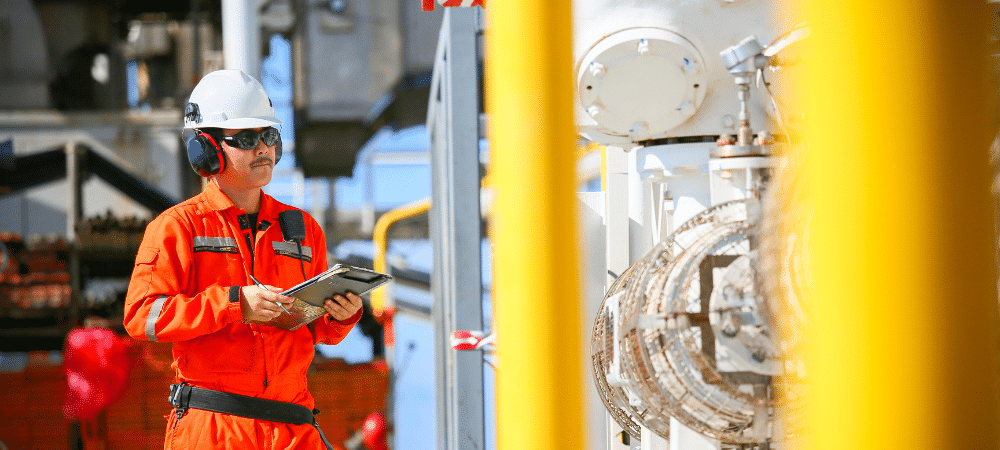April 1, 2024 6 min read

Safety Alerts for the Oil and Gas Industry
Industry:
Solution:

In the high-risk oil and gas industry, staying informed about potential hazards and emerging threats is paramount. Safety alerts for oil and gas play a crucial role, allowing for proactive communication of important safety information. In this blog, we’ll review what these alerts are, why they matter, and a few solutions that can help you improve safety management for your operation.
What Are Safety Alerts?
Safety alerts are concise notifications issued to personnel to raise awareness about specific safety concerns or potential hazards.
These alerts typically provide detailed information about the nature of the hazard, its potential impact, and recommended actions to mitigate or eliminate the risk. They serve as a means of quickly disseminating critical safety information to workers across various levels of the organization, ensuring that everyone is aware of potential dangers and equipped with the knowledge to respond appropriately.
Types of Safety Alerts
Safety alerts can cover a wide range of topics, including but not limited to:
- Hazardous conditions or materials
- Equipment malfunctions or failures
- Unsafe work practices or procedures
- Environmental risks or incidents
- Regulatory compliance issues
These alerts may be issued in various formats. But many modern operations use mobile applications and real-time notifications to keep employees apprised of risks and hazards.

Why The Oil and Gas Industry Needs Safety Alerts
The importance of safety alerts cannot be overstated. The oil and gas industry is considered one of the riskiest industries by the Bureau of Labor Statistics.
By promptly disseminating critical safety information, these alerts help organizations identify and address potential risks before they escalate into serious incidents or accidents. They also facilitate continuous improvement by promoting a culture of transparency, accountability, and shared learning within the industry.
Online Safety Training Courses
In-depth safety training based on OSHA & EPA requirements and general best practices that helps put your learners “on location” and ready to identify and address hazardous conditions.
View Courses
Inherent Hazards of the Industry
From offshore drilling platforms to onshore refineries, from pipelines spanning vast distances to storage facilities housing flammable materials, there are countless opportunities for incidents to occur. Safety alerts help deliver targeted information relevant to their specific roles and environments, ensuring that they are equipped to identify and address potential risks effectively.
Regulatory Compliance Requirements
There are stringent regulatory requirements aimed at protecting workers, the public, and the environment. Regulatory agencies such as OSHA, the EPA, and the Department of Transportation (DOT) impose strict standards for safety, environmental protection, and emergency response.
Safety alerts often serve as a means of communicating regulatory updates, enforcement actions, and compliance obligations to industry stakeholders, helping organizations maintain compliance and avoid costly penalties.
Importance of a Safety Culture
Building and maintaining a strong safety culture is essential for fostering a workplace where safety is prioritized, valued, and ingrained in every aspect of operations.
Safety alerts contribute to this culture by promoting open communication, encouraging proactive hazard identification, and reinforcing the shared responsibility for safety among all personnel.
By regularly receiving and acting upon safety alerts, employees are empowered to take ownership of their safety and the safety of their colleagues, reducing the likelihood of accidents and promoting a safer work environment.

What Are the Most Common Hazards in the Oil and Gas Industry?
The oil and gas industry operates in inherently hazardous environments, characterized by complex operations, high-pressure equipment, volatile substances, and extreme weather conditions. Exploration, drilling, production, transportation, and refining activities pose numerous risks to personnel, assets, and the environment. The most common oil and gas hazards include:
- Hazardous Material Exposure. Workers in this industry frequently handle and are exposed to chemicals and hazardous materials. Exposure to these substances can lead to acute or chronic health effects.
- Fire and Explosions. The presence of flammable gases, vapors, and liquids poses a significant risk of fires and explosions. Ignition sources, such as hot surfaces, electrical equipment, welding operations, and static electricity, can trigger catastrophic incidents that result in loss of life, property damage, and environmental pollution.
- Equipment Failure and Malfunction. Malfunctions or failures of equipment and machinery, including pumps, valves, pipelines, pressure vessels, and drilling rigs, can lead to accidents such as leaks, spills, blowouts, and structural collapses. Inadequate maintenance, improper operation, and material fatigue are common factors contributing to equipment-related incidents.
- Natural Hazards. Oil and Gas operations are often conducted in remote areas, exposing workers to natural hazards such as severe weather events (e.g., hurricanes, storms). These hazards can disrupt operations, damage infrastructure, and pose risks to worker safety.
- Health Hazards. Oil and gas workers may face long-term health hazards associated with prolonged exposure to environmental factors such as noise, vibration, radiation, and ergonomic stressors.
- Human Error. Fatigue, stress, inadequate training, and communication breakdowns can compromise safety and lead to errors in judgment, procedural violations, and lapses in attention.
Oil and gas safety alerts—as well as robust health and safety training—are critical tools to mitigate these risks by raising awareness about specific hazards and providing guidance on how to prevent accidents and injuries.
Vector Solutions’ Safety Alerts for Oil and Gas
Vector Solutions’ LiveSafe is a powerful tool designed to keep employees safe and informed with two-way risk communications, emergency notifications, and other safety tools.
This solution is designed to improve response time to incidents, send instant notifications across multiple channels (e.g., SMS, email, app push notifications), and identify emerging threats in real-time.
Learn more about LiveSafe for oil and gas safety alerts.
Vector’s Industry Leading EHS Management Solution
If you’re looking to make a profound impact on the safety of your workforce, you may want to consider an all-in-one employee health and safety management solution.
Vector EHS Management Software connects all areas of safety into one easy-to-use platform, including:
- Improved incident management and the ability to create accurate OSHA recordkeeping forms
- Faster and more accurate inspections with pre-built and configurable checklists
- SDS and chemical management that is GHS compliant
- Behavior-based safety and job safety analysis
- And so much more!
Vector EHS Management Brochure
Bring all your organization’s EHS activities, tasks, and reports into one single, easy-to-use solution to gain visibility into the data and trends needed to shift from a reactive to a proactive safety culture
Learn More
Interested in learning more about our award-winning safety eLearning courses, safety management software, and learning management system (LMS)? Request a demo today.








